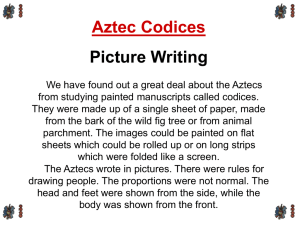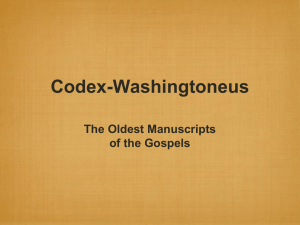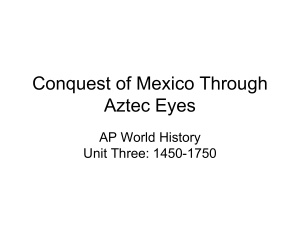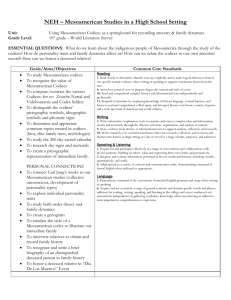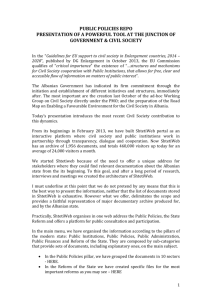memory of the world register nomination form
advertisement
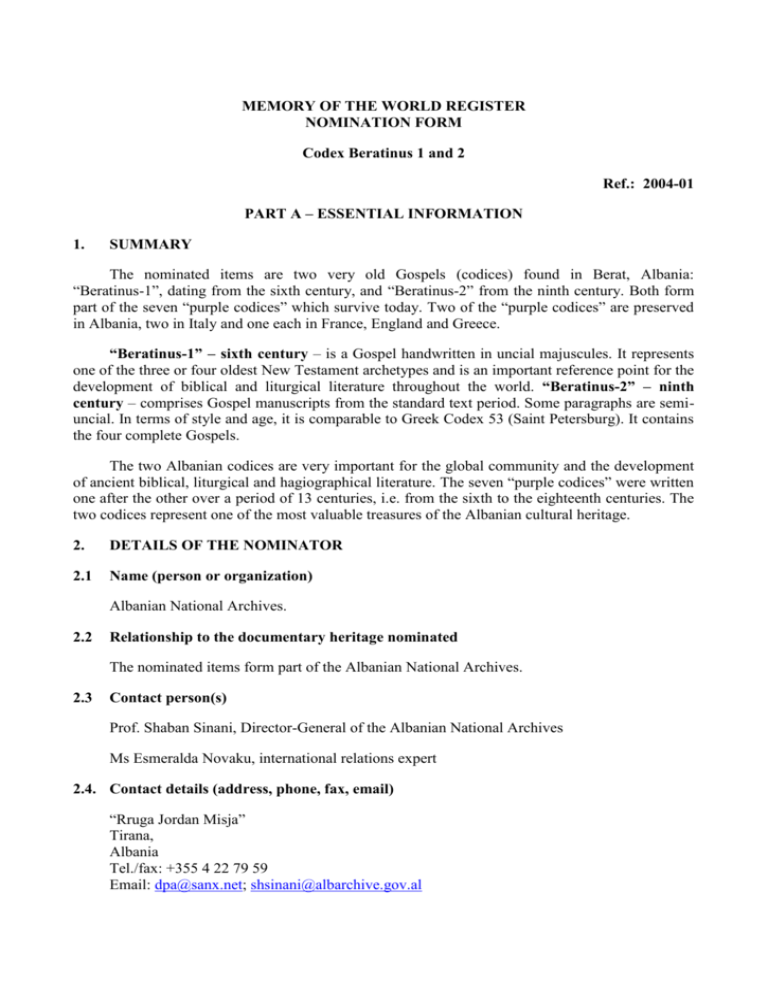
MEMORY OF THE WORLD REGISTER NOMINATION FORM Codex Beratinus 1 and 2 Ref.: 2004-01 PART A – ESSENTIAL INFORMATION 1. SUMMARY The nominated items are two very old Gospels (codices) found in Berat, Albania: “Beratinus-1”, dating from the sixth century, and “Beratinus-2” from the ninth century. Both form part of the seven “purple codices” which survive today. Two of the “purple codices” are preserved in Albania, two in Italy and one each in France, England and Greece. “Beratinus-1” – sixth century – is a Gospel handwritten in uncial majuscules. It represents one of the three or four oldest New Testament archetypes and is an important reference point for the development of biblical and liturgical literature throughout the world. “Beratinus-2” – ninth century – comprises Gospel manuscripts from the standard text period. Some paragraphs are semiuncial. In terms of style and age, it is comparable to Greek Codex 53 (Saint Petersburg). It contains the four complete Gospels. The two Albanian codices are very important for the global community and the development of ancient biblical, liturgical and hagiographical literature. The seven “purple codices” were written one after the other over a period of 13 centuries, i.e. from the sixth to the eighteenth centuries. The two codices represent one of the most valuable treasures of the Albanian cultural heritage. 2. DETAILS OF THE NOMINATOR 2.1 Name (person or organization) Albanian National Archives. 2.2 Relationship to the documentary heritage nominated The nominated items form part of the Albanian National Archives. 2.3 Contact person(s) Prof. Shaban Sinani, Director-General of the Albanian National Archives Ms Esmeralda Novaku, international relations expert 2.4. Contact details (address, phone, fax, email) “Rruga Jordan Misja” Tirana, Albania Tel./fax: +355 4 22 79 59 Email: dpa@sanx.net; shsinani@albarchive.gov.al –2– 3. IDENTITY AND DESCRIPTION OF THE DOCUMENTARY HERITAGE 3.1 Name and identification details of the items being nominated The “Codex Purpureus Beratinus Ф” is also known as “Beratinus-1” or simply “Beratinus”. The “Codex Aureus Antimi” or “Beratinus-2” is known by this name because it is written in gold letters. In 1886, Belgian researcher Batiffol named it “d’Antimi”, in honour of the (metropolitan) bishop Anthimius Alexoudes, “friend of art”, who kept the two codices in his home at the church. 3.2 Description These manuscripts are numbered 1 and 2 in the inventory of “Collection 488” at the Albanian National Archives. “Beratinus-1” comprises 190 pages. In the international list of rare ecclesiastical manuscripts, it carries the alphabetical suffix Ф and the number 043. It contains the majority of the texts of the Gospels according to Saint Mark and Saint Matthew. It is thought that the other two Gospels probably also existed. The manuscript measures 314 mm by 268 mm. Certain passages contain a mixture of text from the “Syriac school” (eastern) and another “western” reading. These passages are known as “conflate reading”. “Beratinus-1” contains nonstandard pre-canonical Gospel passages. It is an indispensable reference point for international research on literary textology and is extremely valuable in terms of the history of handwriting and the calligraphic elements of applied figurative art. It is particularly important because it is comparable both chronologically and typologically to the very well-known codices of Rossanensis, Sinopensis, Petropolitanus and Vaticana B. Its colour reflects divine respect for the holy scriptures. The letters and words are not separated from one another (scriptio-continua). It is a pre-standard type of Gospel manuscript (Gospel manuscripts became canonical from the seventh century onwards). The letters are silver and the initials gold; the manuscript is on parchment. It contains several gold abbreviations, typical of ancient Christianity. “Beratinus-2” comprises 420 pages, some simple miniatures and portraits. The manuscript measures 240 mm by 190 mm. It includes all four Gospels. The letters are all gold and the manuscript is on parchment. The text is from the standard text period and includes some semiuncial letters. The reference number of “Beratinus-2” is 1143 (Gregory-Aland) in the international list of Gospel manuscripts. ORIGIN “Beratinus-1” dates back to the first half of the sixth century. It was found in a church in Berat. There is some indication that at an early stage, in the sixth century, it was given to a church in southern Illyricum (Illyria) by the Emperor of Constantinople. The first person to describe the manuscript held at the church of Saint George (Berat) was the bishop of the metropolis of Berat, Anthimis Alexoudes, who said that it was an exceptionally valuable part of the global heritage of biblical literature. The origin of this manuscript has been and remains a matter of debate. In 1943, the Berat church council hid the manuscript because Hitler’s army wanted to take it away, together with the gold from the Bank of Albania, for what they called “security reasons”. –3– “Beratinus-2”. This manuscript, which dates back to the ninth century, was found in a church in Berat. The first person to make it known in biblical literature circles was the bishop of the metropolitan church of Berat, Anthimis Alexoudes. The codex contains simple miniatures (Gospel portraits). The origin of this manuscript has been and remains the subject of much debate. In 1967, after a long period during which they were thought to have been lost, both codices were found and were handed over to the National Archives in 1971. PHYSICAL CONDITION The physical condition of the “Codex Purpureus Beratinus Ф” and the “Codex Aureus Antimi” has deteriorated significantly over the years. “Beratinus-1” has nearly been stolen at least four times since the thirteenth century and “Beratinus-2” three times since the fourteenth century. On the first occasion, it was the “Franks from Champagne” who tried to take them, followed by the army of Tsar Uroš (King Uroš) in 1356; then it was the turn of the Austrian army in 1914 and, finally, of Hitler’s army in 1944, during the Second World War. After the liberation, Albanian researchers noticed that the two medieval codices were missing. They did not discover where they had been hidden for a long time. They checked the internal façade of the church in Berat, from which they removed three stone slabs. They found the two codices inside, both covered in straw. They were in a metal cover and the pages inside were damp and mouldy. In the 1970s, in accordance with an intergovernmental agreement between Albania and China, the “Codex Purpureus Beratinus Ф” and the “Codex Aureus Antimi” were sent to the Institute of Archaeology at the Chinese Academy of Science to be restored. Identical reproductions were then created so that they could be fully accessible to researchers. As the originals were being restored, great care was taken to avoid aggravating the critical condition they were in. They can now be preserved for a long time, since the pages were hermetically sealed in a vacuum between two sheets of glass. After being restored, the “Codex Purpureus Beratinus Ф” was divided into nine volumes and the “Codex Aureus Antimi” into 21. Today, they are kept at the Albanian National Archives in Tirana, in a strongroom financed by UNESCO. VISUAL DOCUMENTATION The manuscripts also exist in microfilm form. A documentary film about the manuscripts was produced on the occasion of their presentation at the “I Vangeli dei Popoli” exhibition. PUBLICATIONS DESCRIBING THE HERITAGE Anthimi, Alexoudes: Title in French: “Description abrégée et historique de la sainte métropole de Belgrade, aujourd’hui Berat”, Crete 1886. Anthimi, Alexoudes: ed., 1902. Batiffol, Pierre: “Les manuscrits grecs de Berat d’Albanie et le Codex Purpureus”, Paris 1886. Sinani, Shaban: “Le château de la vertu”, Tirana 2001. Sinani, Shaban: “The codices of Albania” (ed.), Albanian National Archives, Tirana 2003 (Published with financial assistance from UNESCO). –4– ASSESSMENT BY THREE EXPERTS OR INDEPENDENT ORGANIZATIONS AWARE OF THE IMPORTANCE OF THE DOCUMENTARY HERITAGE: – Koder, Johannes: “Zur wiederentdeckung zweir Codices Beratini”, Byzantinische Zeitschrift 65 (1972). – Battifol, Pierre: “Les manuscrits grecs de Berat d’Albanie et le Codex Purpureus Ф”, Paris 1886. – Battifol, Pierre: “Evangeliorum Codex Graecus Purpuraeus Beratinus Ф”, published in “Mélanges d’archéologie et d’historie” (École française de Rome) 5 (1885). – Crisci, Eduardo: “Vangeli di Matteo e Marco”, in “I Vangeli dei Popoli”, Edizione di Rinnovamento nello Spirito Santo, Cita di Vaticano, pp. 130-133. – Mullen, Roderic L.: “Bibliography of the New Testament and Related Manuscripts”, Albanian National Archives, Collection 488, Tirana – 2002. – Zanichelli, Giusi: “Lo stato degli studi e il dibattito critico sugli scriptoria in Albania”, ed. Antichità Altoadriatiche. – Sinani, Shaban: “The codices of Albania” (ed.), published by Albanian National Archives, Tirana 2003. 4. JUSTIFICATION FOR INCLUSION/ASSESSMENT AGAINST CRITERIA 4.1 Authenticity In 1868, the existence of the “Codex Purpureus Beratinus Ф” and the “Codex Aureus Anthimi” was recognized for the first time in academic and religious circles in a Greek-language publication by the bishop of Berat. His book, “Description abrégée et historique de la sainte métropole de Belgrade, aujourd’hui Berat”, written in French, was published in Corfu in 1868. A few years later, in 1881, an article by the researcher Ludovico Duchesne, who described the manuscript as a “Greek manuscript on purple parchment, written in silver letters”, was published in the journal Bulletin critique. In 1886 (Editions Imprimerie nationale, Paris), Pierre Batiffol wrote and published “Les manuscrits grecs de Berat d’Albanie et le Codex Purpureus”. In 1900 and 1902, Alexoudes published new editions of the codices. One hundred and thirty years ago, world-renowned Belgian researcher Pierre Batiffol visited the church of Saint George in Berat. In his book, he drew a palaeographical comparison between “The Greek manuscripts from Berat in Albania” and the “Codex Purpureus Ф”, and the manuscript of the “purple codices of Berat” (“Beratinus-1”) and the “Liturgy of Saint John Chrysostom”. He concluded that “both manuscripts may share the same author: Saint John Chrysostom”. It is thought that the “purple codices of Berat” were written by Saint John Chrysostom. There is indirect information to suggest that they are closely related. The studies carried out by the historian Prof. Kristo Frasheri on early Christianity in Albania (“Studia Albanica 2000”) suggest that the codex remained in Albania only because, according to liturgical rituals, the “purple codex” of Berat was presented to the believers only once a year, on the feast of Saint John Chrysostom. In 1929, Giuseppe Valentini wrote that Chrysostom was exiled in southern Albania two years before his death. In conclusion, it is chronologically proven that “Beratinus-1” dates back at least to the sixth century, although it may go even further back to Saint John Chrysostom’s lifetime (he died in 407). –5– A manuscript as old as “Beratinus-1” has true global importance and helps to explain the development of literature and evangelical doctrine through specific textual criticism. Traces of eastern and western Syriac writings have been found in the typology of this manuscript, a theory supported by several researchers. “Beratinus-2” This is one of the seven “purple codices” in the world to have survived to the present day. It contains Gospel writings from the standard text period. This manuscript is an essential landmark in evangelical literature and Christian culture in general. It is a unique record of the development of the world’s ancient evangelical and liturgical literature (model of evangelical writings in minuscules). 4.2.1 World significance, uniqueness and irreplaceability “Beratinus-1” The “purple codex” of Berat is one of the oldest examples of New Testament writings. It is among the three or four oldest evangelical manuscripts in the world. This manuscript is an essential landmark for evangelical literature and Christian culture in general and is described as “one of the oldest codices in the Christian world” by the Albanian historian Theofan Popa. Belgian academic Pierre Batiffol refers to its global significance and its uniqueness and irreplaceability in his book “Les manuscrits grecs de Berat, d’Albanie et le Codex Pourpre Ф”. The two codices help to reveal the wealth and diversity of the great treasures of the spiritual heritage of the Albanian people, besides forming a record of the history of human thought. They are inestimably valuable in terms of the history of handwriting, calligraphy and figurative applied arts, and as objects of palaeography and bibliology. The seven “purple codices” are: (1) Aleph or Sinaiticus (British Library), third century; (2) Sinopensis (French National Library, Paris), fourth/fifth century; (3) Beratinus-1, sixth century; (4) Beratinus-2, ninth century; (5) Rossanensis (Diocese of Rossano, Italy), sixth century; (6) Vaticana B (Biblioteca Apostolica Vaticana), fourth century; (7) Petropolitanus (Athens Museum), eighth/ninth century. The International Bible Society, which is based in London, is translating the New Testament using references from the world’s oldest manuscripts, in the hope that it can produce a text which, from a scientific point of view, can be accepted by all churches. It considers the Albanian codices to be among the most important foundations of this initiative. “Beratinus-2” This is one of the seven “purple codices” in the world to have survived to the present day. It contains Gospel writings from the standard text period. This manuscript provides unique evidence of the development of ancient evangelical and liturgical literature. Albanian historian Kristo Frasheri believes that Batiffol was wrong to place the “Codex Aureus Antimi” in the tenth century and to describe the “Codex Theodhorae” as older. Roderic L. Mullen, a professor at Birmingham University, compares it with the ninth century Greek Codex 53 (Saint Petersburg). –6– 4.3. Criteria TIME “Beratinus-1” (“Purple codices of Berat”) dates back to the first half of the sixth century (or earlier). This period is known as the “deep purple period”. As we have already mentioned, its chronology is demonstrated by: its colour, which expresses divine respect for holy scriptures; the use of purple parchment and gold and silver letters, forming part of the handwriting technique that did not begin until the start of the fourth century and was no longer used in evangelical literature after the sixth century. The letters and words are not separated from one another (scriptio-continua). This type of writing (scriptio-continua) was not used after the sixth century. The uncial letters are older than evangelical writings. The manuscript is a pre-standard Gospel text. “Beratinus-2” dates back to the ninth century. (For more information, see the study by Prof. Shaban Sinani: “The codices of Albania”). SUBJECT AND THEME These texts form part of Gospel literature. They contain non-standard pre-canonical passages. The second codex contains standard texts. They are religious manuscripts, forming part of biblical literature (“Beratinus-1” is one of the oldest examples of the New Testament). (Its 190 pages of silver lettering contain two Gospels: Saint Matthew and Saint Mark.) “Beratinus-2” contains four Gospels. FORM AND STYLE “Beratinus-1” is a 190-page Gospel manuscript in majuscules. The manuscript measures 314 mm by 268 mm. The letters are silver and the initials gold. It is written on parchment and also contains ornaments. The letters and words are not separated from one another (scriptio-continua). The cover is very beautiful but from a later date. After being restored, the pages were placed in a vacuum between sheets of glass. They also exist in microfilm form and as transliterated text for consultation. “Beratinus-2” is a 420-page Gospel manuscript in minuscules. The manuscript measures 240 mm by 190 mm. It is considered to have unique value as far as ecclesiastical manuscripts are concerned. All the letters are gold, the parchment is purple and there are also ornaments on the metal cover, mainly geometrical figures and simple motifs, without any direct Christian symbols; they are mostly secular and pagan motifs. There are also simple ornaments in the text itself. After being restored, the pages were placed in a vacuum between sheets of glass. They also exist on microfilm and as transliterated text for consultation. 4.4 Rarity, integrity, threat and management “Beratinus-1” This represents one of the three or four oldest codices in the history of world Christian literature and one of the three or four oldest New Testament archetypes. It is an important landmark in the development of biblical and liturgical literature throughout the world. “Codex Purpureus Beratinus Ф” survived until 1967, since when it has been preserved in high security conditions. As far as integrity is concerned, it is complete and unaltered. When it was found, it had a metal cover and the pages inside had been damaged by damp and mould. In the 1970s, in accordance with an intergovernmental agreement, the “Codex Purpureus Beratinus Ф” was sent to China, where it was restored using the technique of hermetically sealing the pages in a vacuum between two sheets of –7– glass. After being restored, the “Codex Purpureus Beratinus Ф” was divided into nine volumes, which are now kept at the Albanian National Archives in Tirana, in a strongroom financed by UNESCO. “Beratinus-2” As far as the integrity of the manuscript is concerned, it is complete and unaltered. When it was found, it had a metal cover and the pages inside had been damaged by damp and mould. In the 1970s, it too was restored in China using the technique of hermetically sealing the pages in a vacuum between two sheets of glass. After being restored, the “Codex Aureus Anthimi” was divided into 21 volumes, which are now kept at the Albanian National Archives in Tirana. (For more information, see the study by Prof. Shaban Sinani: “The codices of Albania”.) 5. LEGAL INFORMATION 5.1 Owner of the documentary heritage This item of Albanian heritage is owned by the State of Albania. 5.2 Custodian of the documentary heritage Both codices are preserved at the Albanian National Archives, under the authority of the Council of Ministers. They are part of the “cultural heritage” of the State of Albania. Contact: Tel./fax: + 355 4 22 79 59; email: dpa@sanx.net; shsinani@albarchive.gov.al 5.3 Legal status The Albanian National Archives are legally responsible for safeguarding the two codices. They may not be taken abroad without the consent of the Council of Ministers. According to Archives Act 9154 of 6 November 2003, “Beratinus-1” and “Beratinus-2” form part of the national archives. They are classified as unique treasures and enjoy the special status of documents of great national and international historical importance. (a) Category of ownership Apart from the originals, the other forms (microfilm and transliterated text) have the same status as the other documents preserved in the archives. (b) Accessibility The originals are accessible only to researchers in the fields of ancient Christian history, literary criticism and palaeography. (c) Copyright status Both codices form part of the intellectual heritage of Albania, under the administration and on behalf of the National Archives. (d) Responsible administration Albanian National Archives. –8– 6. MANAGEMENT PLAN 6.1 They are kept in a “strongroom” and may be consulted on microfilm. In very rare and exceptional cases, they may be loaned in part (even the originals) to eminent researchers. The National Archives are currently preparing a transliteration of “Beratinus-1” and an Englishlanguage version of the catalogue “The codices of Albania”. Prof. Shaban Sinani, Director of the National Archives, has completed the monograph “Beratinus” (400 pages), which is currently being published. – Exhibitions planned for 2005-2006. 7. CONSULTATION See enclosed letter. PART B – SUBSIDIARY INFORMATION 8. ASSESSMENT OF RISK 8.1 The two codices, “Beratinus-1” (“Codex Purpureus de Berat”) and “Beratinus-2” (“Codex Aureus Anthimi”), are not in any danger. 9. ASSESSMENT OF PRESERVATION 9.1 The codices are kept in a “strongroom”, which was built with UNESCO funding and provides maximum security conditions. Temperature, humidity and other factors are regulated in accordance with recommendations for this type of documentary heritage. PART C – LODGEMENT This nomination is lodged by: Prof. Shaban Sinani, Director-General of Archives and Esmeralda Novaku, International Relations Expert for the Albanian National Archives National Commission for UNESCO. Permanent Delegation of Albania to UNESCO. On behalf of the Albanian National Archives (Signature)………………………………… (Date)……………………………………… –9– Stema Deputy Prime Minister Tirana, /03/04 Sir, On behalf of the Government of the Republic of Albania, I should like to express my warmest thanks and highest regard for your admirable efforts to safeguard and promote the values of the cultural heritage. We should value very highly your personal support for the registration of Albania’s two longest surviving codices, which are among the oldest in the world, “Beratinus-1” and “Beratinus2”, in the “Memory of the World” programme for the protection of the spiritual heritage of nations. Indeed, you expressed your esteem for these documents in the preface to The Codices of Albania, which was published with UNESCO’s support. We share your view that the two purple codices of Berat are treasures of the global heritage. They are of universal importance and their inclusion in the “Memory of the World” register will make them more accessible to the public and will illustrate the expression of difference and of cultural pluralism, which the Albanian Government considers to be essential values. “Beratinus-1” and “Beratinus-2” are true masterpieces of religious art and important evidence of the development of Christian thought. We are sure that their inclusion in the register will help to safeguard and promote this heritage, which belongs not only to Albania but to the whole world. With my warmest thanks, please accept, Sir, the assurances of my highest consideration. Namik Dokle Mr Koïchiro Matsuura Director-General UNESCO Headquarters 7, Place de Fontenoy 75007 Paris
